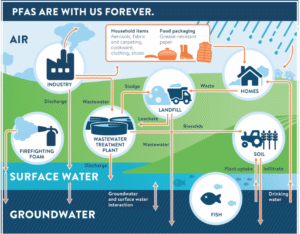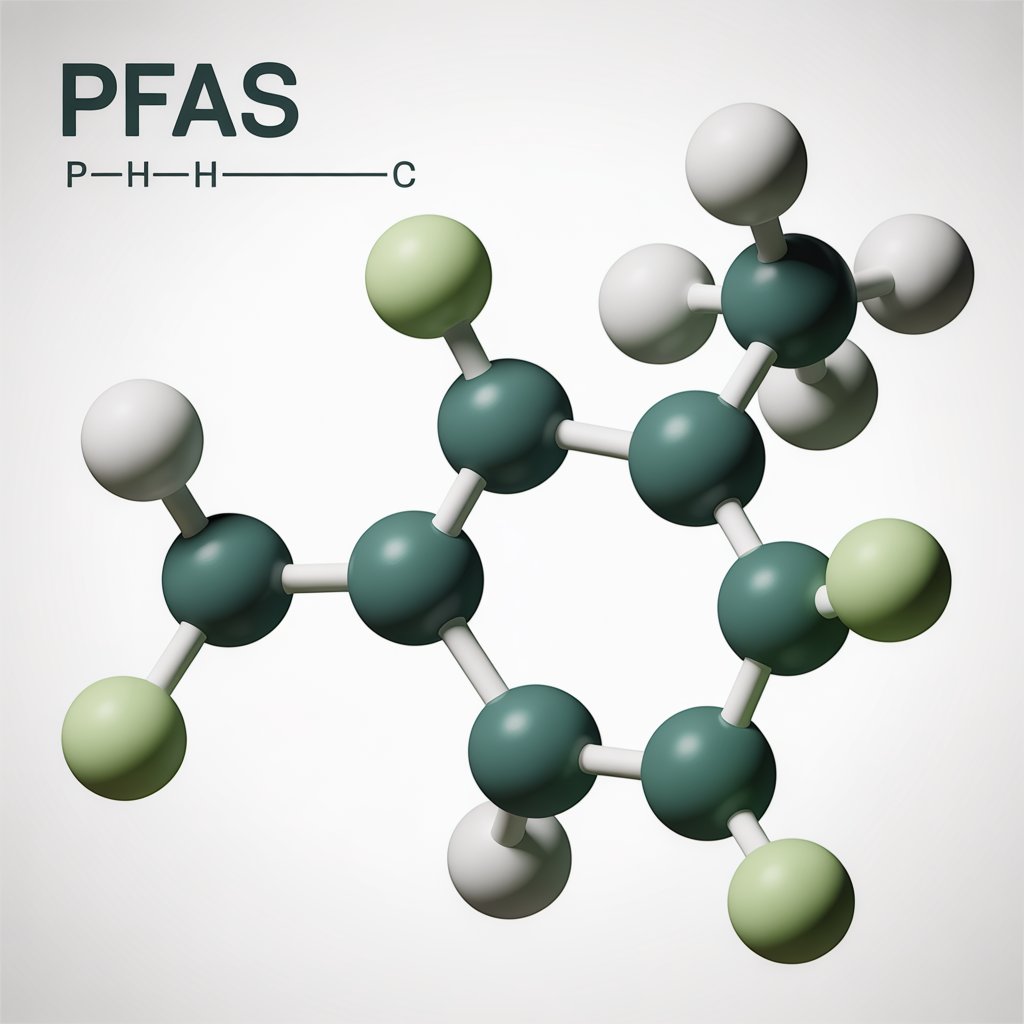
- Nick Water DR
- Published
- Updated October 27, 2025
- Water contaminants
An overview of contamination of UK drinking water
Understanding what’s in our drinking water really matters because long-term, low-level exposure to certain contaminants may pose health or ecological risks, even when individual concentrations appear small. Filtering your water at home provides an additional line of defence in an era of increasing pollution to our rivers , ageing infrastructure, chemical complexity, and evolving environmental pressures .
PFAS – “Forever Chemicals”
Per- and polyfluoroalkyl substances (PFAS) are a large family of synthetic chemicals used in industrial processes, non-stick cookware, firefighting foams, and water-resistant products. Known as “forever chemicals” because they do not readily degrade, PFAS persist in the environment and can accumulate in soil, water, and human tissue. In the UK contamination originates primarily from historical use at airfields, military sites, and chemical manufacturing plants, where aqueous film-forming foams were widely applied. Landfill leachate and wastewater treatment discharges also act as ongoing sources. PFAS are extremely stable due to their strong carbon–fluorine bonds, making them resistant to degradation and capable of persisting for decades in groundwater and surface water. They can accumulate in aquatic organisms and even appear in treated drinking water. Studies have detected trace levels in most rivers , the UK water companies are beginning to map PFAS hotspots and implement advanced treatment to meet DWI guidance limits of 0.1 µg/L for individual PFAS and 0.5 µg/L for total PFAS. The Global policy trend is for a much more systematic and broader statutory approach to prevent the environmental situation from worsening..

Plastics – Micro and Nano
Microplastics and nanoplastics enter UK water systems from a wide variety of sources .These particles originate from the fragmentation of larger plastics such as packaging, bottles, and car tyres, as well as from synthetic fabrics that shed fibres during washing. Wastewater treatment plants capture much of this material in sludge, but smaller fragments—especially nanoplastics—can pass through filters and flow into rivers and coastal waters. Stormwater runoff from urban areas, road wear, and littering further contribute to environmental loading. Once in aquatic environments, microplastics can adsorb toxic chemicals such as bisphenols , phthalates , PCBs and PBDEs and PFAS acting as mobile pollution vectors. Some may even re-enter drinking water supplies via surface water abstraction or groundwater infiltration. Although no UK legal standards currently exist for plastic particles in water, monitoring programmes are being expanded, and research is exploring advanced filtration and coagulation techniques to capture these persistent contaminants before they reach consumers.
Agricultural Runoff – Pesticides and Herbicides
Agricultural activity remains one of the most significant diffuse pollution sources in the UK. Pesticides and herbicides, including glyphosate, 2,4-D, and neonicotinoids, are applied to control weeds and insects but can leach into soil and drain into rivers during rainfall or irrigation. Runoff from fields, especially those with poor soil structure or steep slopes, carries residues into ditches, groundwater, and reservoirs used for drinking water abstraction. In catchments dominated by arable or horticultural production, such as eastern and southern England, concentrations can spike after spraying seasons. Even low levels are of concern because many of these compounds are biologically active and degrade slowly. UK regulations set a strict limit of 0.1 µg/L for any single pesticide and 0.5 µg/L for the total sum in drinking water. Mitigation strategies include vegetated buffer strips, integrated pest management, and targeted chemical application guided by soil and weather monitoring.
Industrial Solvents – TCE and Benzene
Industrial solvents like trichloroethylene (TCE) and benzene are legacy pollutants in many urban and industrial areas of the UK. TCE was historically used for metal degreasing, dry cleaning, and chemical manufacturing, while benzene is a component of petrol and a by-product of refining and combustion. Leakage from underground fuel tanks, industrial storage sites, and waste disposal facilities has led to contamination of soil and groundwater. Once released, these volatile organic compounds (VOCs) can migrate through the subsurface and volatilize into the atmosphere, complicating remediation efforts. Urban groundwater beneath older industrial zones, such as former gasworks or engineering sites, often requires close monitoring. The UK Drinking Water Regulations restrict benzene to 1 µg/L and TCE to 10 µg/L. Treatment methods include air stripping, activated carbon adsorption, and remediation of contaminated soils to prevent further leaching into aquifers used for public supply.
Heavy Metals
Heavy metals such as lead, arsenic, mercury, cadmium, and chromium enter UK water systems from both natural and human sources. Geologically, some regions—particularly those underlain by mineral-rich strata—release trace metals through natural weathering. However, anthropogenic sources dominate: mining residues, industrial effluents, historical smelting sites, and runoff from roads and urban infrastructure all contribute. In older properties, corrosion of lead pipes and solder joints remains a major concern, particularly where water has low pH or hardness, which accelerates metal dissolution. Road runoff carries zinc and copper from tyre and brake wear, while landfill leachate and incinerator ash can introduce multiple metals into groundwater. Chronic exposure poses serious health risks, including neurotoxicity and organ damage. The UK Drinking Water Inspectorate enforces some limits . Mitigation involves corrosion control, pipe replacement, and treatment processes such as ion exchange and metal-oxide adsorption.
Emerging Contaminants – Pharmaceuticals and Hormone Residues
Pharmaceuticals, personal care products, and hormone residues are increasingly detected in UK rivers and, occasionally, treated water. These contaminants originate mainly from human and veterinary medicine—antibiotics, antidepressants, painkillers, and contraceptive hormones that pass through the body and enter wastewater systems. Hospital effluent, domestic sewage, and improper disposal of medicines down household drains all contribute to environmental release. Wastewater treatment plants are not specifically designed to remove such micropollutants, so trace residues often persist in effluent discharged to rivers. Downstream, these substances can disrupt aquatic life—altering fish reproduction and microbial balance. Surveys in the Thames and Avon catchments have detected pharmaceutical residues at nanogram-per-litre levels. While no statutory UK limits exist, pilot studies are exploring advanced treatment options such as ozonation and activated carbon adsorption. Source control measures, including take-back schemes for unused medicines, are also being promoted to prevent unnecessary contamination at the household level.

Chlorine Byproducts – THMs, HAAs, and Bromate
Chlorine and hypochlorite are indispensable disinfectants in UK water treatment, but they can react with naturally occurring organic matter, bromide, and other compounds to form disinfection by-products (DBPs). Trihalomethanes (THMs) and haloacetic acids (HAAs) form primarily in surface waters rich in humic and fulvic substances—especially during warm weather when reaction rates increase. Bromate typically arises when ozonation or chlorination occurs in bromide-containing groundwater, such as coastal aquifers. Industrial discharge, decaying vegetation, and agricultural runoff all raise organic precursor levels, heightening DBP formation potential. UK regulations limit total THMs to 100 µg/L and bromate to 10 µg/L. To reduce formation, water companies try to optimise pre-treatment (coagulation, filtration) to remove organic matter and carefully control chlorine dosing. The balance between microbial safety and chemical minimisation is a key operational focus, ensuring water remains both pathogen-free and chemically compliant.
Fluoride – Natural and Added

Fluoride in UK water originates from both natural geological sources and controlled addition for dental health. Groundwater drawn from chalk and limestone aquifers often contains naturally elevated fluoride due to mineral dissolution. Artificial fluoridation, implemented in certain regions such as the West Midlands and parts of the North East, involves adding hexafluorosilicic acid to achieve a concentration of around 1 mg/L—optimal for preventing tooth decay. Industrial sources, including aluminium smelting and phosphate fertiliser production, can also release fluoride into surface waters, though this is now tightly regulated. Excess fluoride exposure may lead to dental or skeletal fluorosis, so the UK standard limits concentrations to 1.5 mg/L. Water companies monitor fluoride routinely and adjust levels to remain within safe thresholds. Treatment for excessive natural fluoride includes activated alumina adsorption or reverse osmosis. Public consultation continues to guide regional fluoridation policies balancing health benefits with ethical and environmental concerns.
Biologicals – E. coli and Cryptosporidium
Biological contaminants enter UK water supplies mainly through faecal pollution and runoff from agricultural or urban environments. E. coli indicates faecal contamination from sewage leaks, septic tanks, or livestock waste washed into rivers, while Enterococci serve as additional markers of sanitary failure. Cryptosporidium and Giardia—chlorine-resistant protozoan parasites—originate from animal faeces and can survive for months in surface water. Norovirus, a highly infectious human virus, can also infiltrate supplies following sewage contamination or flooding. Heavy rainfall or extreme weather increases the risk of pathogens entering reservoirs and distribution networks. Modern treatment plants use multi-barrier systems—coagulation, filtration, and disinfection—but occasional breaches can occur if raw water quality declines sharply.

About the Author
Nick Smith | Founder | The Water Dr. & Cellthyhomes
Nick has dedicated years to studying building biology, healthy living environments, and the impact of environmental toxins on inflammation.
Whilst regulations for UK drinking water are slow to adapt, & influenced by conflicts of interest, Nick conduct comprehensive research on global regulations & scientific literature to offer water filtration solutions that provide clean drinking water free from all harmful contaminants.


